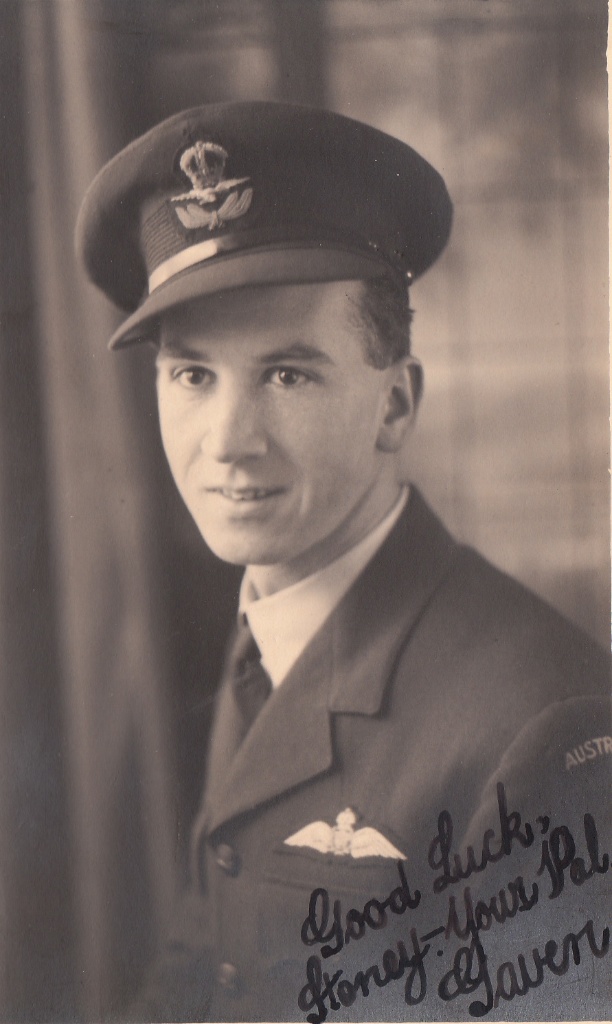Australian Crew
A bomber crew consisted of men brought together by the vagaries of war and who otherwise might never have formed an acquaintance even if their paths had crossed in civilian life. Men in bomber training differed in age, education, employment, temperament, and interests. Many were so young that they had not yet even settled on a civilian career. The one trait all air crew shared was their willingness to volunteer for a dangerous job.
| Name | Enlisted | RAAF Service # |
Pre-war Occupation and Residence |
Trade | Rank & Age at Crewing Up in May 44 | ||
| Gaven W. Henry |
10-Oct-42 | 428847 | bank clerk |
Walcha NSW |
pilot | Flight Sergeant | 23 yr 3 mo |
| H. A. Stoney Mitchell |
24-Apr-43 | 433608 | solicitor | Moree NSW |
navigator | Pilot Officer | 33 yr 3 mo |
| Mervyn H. Bertie |
12-Apr-43 | 433499 | accountant’s clerk |
Orange NSW |
bomb aimer | Sergeant | 23 yr 2 mo |
| Keith C. McGinn |
26-Feb-43 | 435018 | student | Mackay QLD |
wireless operator | Flight Sergeant | 19 yr 3 mo |
| Harvey J. Porter |
08-May-43 | 433742 | government clerk |
Five Dock NSW |
mid-upper gunner | Sergeant | 19 yr 2 mo |
| John W. Grice |
26-Mar-43 | 435168 | student | Charleville NSW |
rear gunner | Sergeant | 19 yr 3 mo |
At 33 years of age, Stoney Mitchell was by far the oldest member of the crew that formed in May 1944. The next oldest, Gaven Henry and Mervyn Bertie, were both born in 1921 and thus 10 years younger than Mitchell. The remaining three, Keith McGinn, Harvey Porter, and Jack Grice, had all recently celebrated their 19th birthdays.
At “crewing up”, Mitchell as a Pilot Officer was the only commissioned crew member. As was the convention in the RAF, pilot Gaven Henry was the captain of the crew regardless of the fact that Mitchell was much older and held a higher rank.

Gaven W. Henry, RAAF Pilot.
Original photograph in Gail Michener’s private collection.
After further training at No 1656 Heavy Conversion Unit (HCU) at RAF Lindholme in late September/early October 1944, where the six Australians were joined by British Flight Engineer Ken Foster, the 7-man crew moved on to No 1 Lancaster Finishing School (LFS) at RAF Hemswell in mid-October, finally joining 103 Squadron at RAF Elsham Wolds in late October. After two training flights in early November 1944, the six Australians flew thirteen operations together from 16 November 1944 to 28 January 1945 (see 13 Ops). Ken Foster, who turned 21 a few weeks after joining the crew at HCU, flew eleven of these operations. Foster missed two of the January sorties due to tonsillitis and another RAF flight engineer, A. Dowie, joined the six Australians on those two operations.
Gaven Henry received his commission as Pilot Officer on 30 July 1944, Stoney Mitchell was promoted to Flying Officer on 25 August 1944, and Merv Bertie received his commission as Pilot Officer on 9 January 1945.
In late January Gaven Henry broke his wrist while cranking Stoney Mitchell’s car to get it started on a cold night. While waiting for his wrist to heal, Henry was posted to 13 Base, also at Elsham Wolds. Coincidently, he was promoted to Flying Officer on 30 January 1945. Sadly, before Gaven Henry’s wrist had healed enough for him to return to operations, the three youngest Australian crewmen were killed in separate operational accidents over Europe on 2, 8, and 12 March 1945 (see In Memoriam). Thus an unlucky civilian accident irreparably broke up the Australian crew.
Fates of the Australian crew in 103 Squadron:
| Name | Trade | RAAF Service Number |
Rank as of March 1945 |
Fate | Death | War Grave |
| Gaven Henry |
pilot | 428847 | Flying Officer | Returned to Australia 04 Nov 1945 |
21 Sep 2011 | |
| Stoney Mitchell |
navigator | 433608 | Flying Officer | Returned to Australia 15 Apr 1946 |
08 Aug 1984 | |
| Merv Bertie |
bomb aimer |
433499 | Pilot Officer | Returned to Australia 02 Apr 1946 |
23 Nov 1987 | |
| Keith McGinn |
wireless operator |
435018 | Flight Sergeant | Killed in action bombing Dessau |
08 Mar 1945 | Reichswald Forest War Cemetery, Germany |
| Harvey Porter |
mid-upper gunner |
433742 | Flight Sergeant | Killed in action minelaying Kattegat |
12 Mar 1945 | Tarm Isolated Grave, Denmark |
| John Grice |
rear gunner |
435168 | Flight Sergeant | Killed in action bombing Mannheim |
02 Mar 1945 | Dürnbach War Cemetery, Germany |
Ken Foster, the seventh crew member and the only RAF airman in Gaven Henry’s otherwise Australian crew, survived the war and died 4 April 1996 in Deal, England.
See In Memoriam for further details of aircrew killed in action.
See Englændergraven, the Danish name for the Tarm Isolated Grave, for details of the burial of Porter and Morris.
See Crew Positions for a diagram showing each crew man’s working location within a Lancaster.
